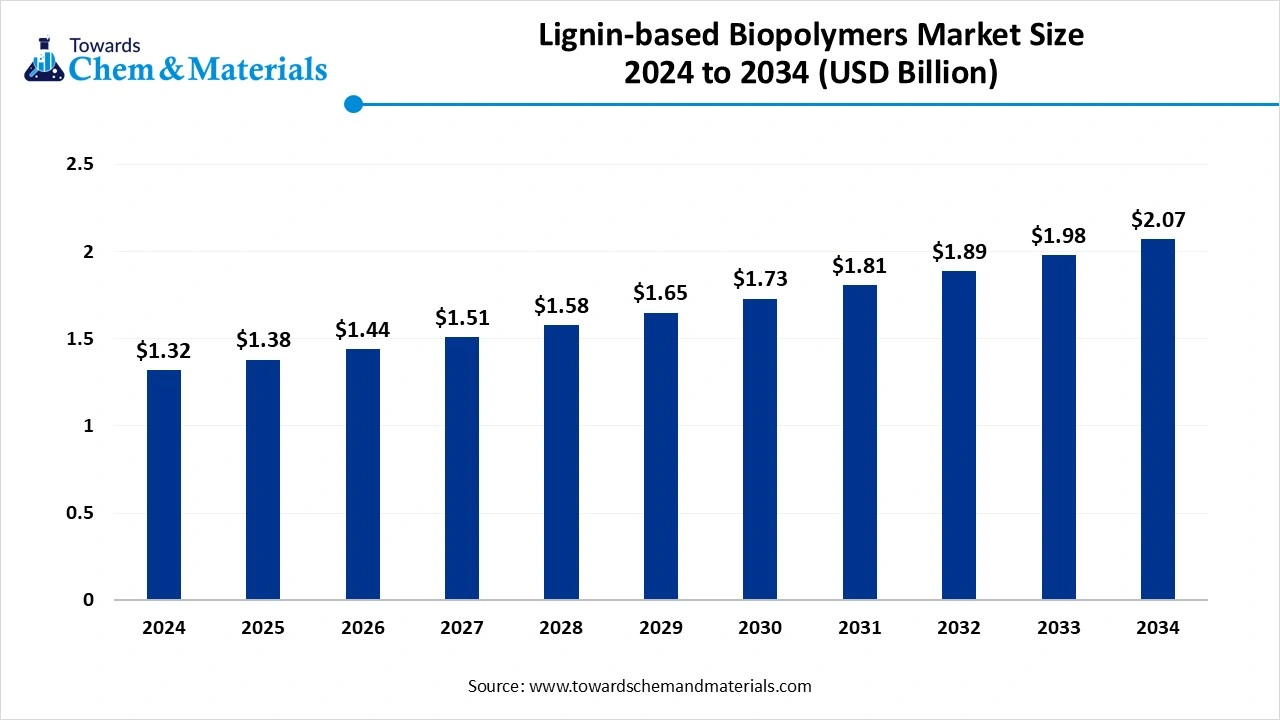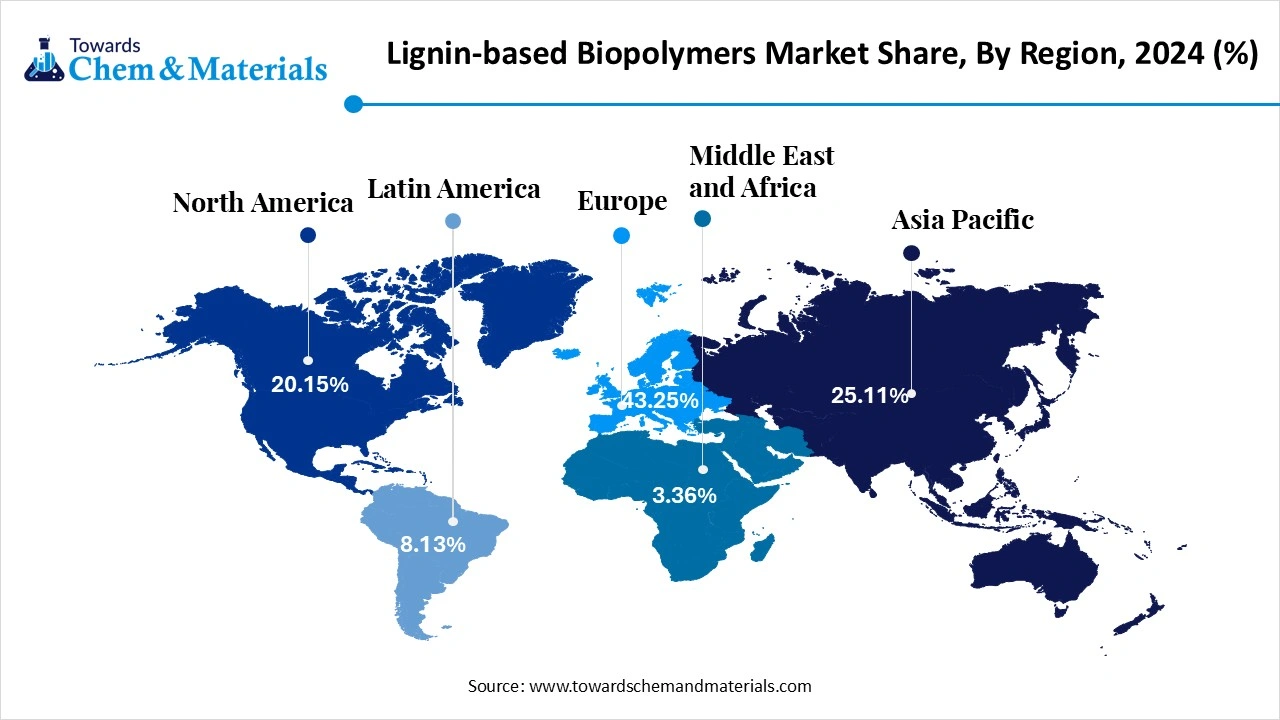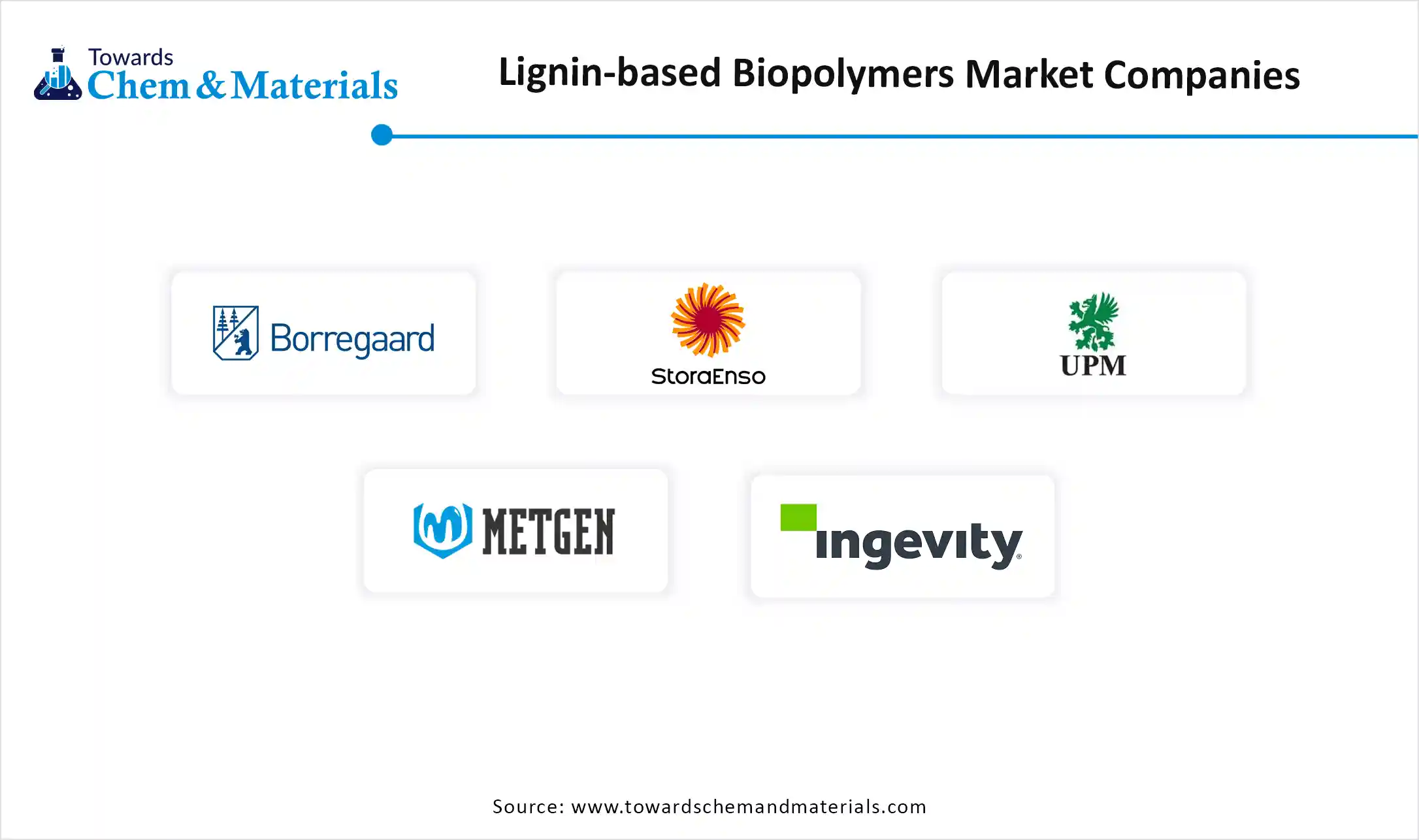December 2025
The global lignin-based biopolymers market size accounted for USD 1.32 billion in 2024 and is predicted to increase from USD 1.38 billion in 2025 to approximately USD 2.07 billion by 2034, expanding at a CAGR of 8.11% from 2025 to 2034. Increasing demand for sustainable packaging solutions is the key factor driving market growth. Also, the innovations in fractionation technologies coupled with the scalable and cost-effective availability of lignin from the paper and pulp industry can fuel market growth further.

The market possesses biodegradable polymers extracted from lignin, a plant-originated byproduct, utilized as an eco-friendly option to petroleum-based plastics. Lignin is one of the most abundant polymers on Earth. Hence it is a readily renewable and available resource. Lignin has a complicated chemical structure with different functionalities that can be used and modified for numerous applications. The material's UV resistance, rigidity, and compatibility with thermoplastic and thermoset systems make it convenient for use in, coatings, adhesives, automotive parts, and composite panels. Global efforts to minimize carbon emissions to support sustainable practices are expected to propel market growth shortly.
Governments across the globe are promoting he market through various measures, such as funding for research and development, regulatory incentives and optimising the utilisation of regulatory incentives. Governments are providing grants, tax breaks and other financial incentives to impel companies to invest in lignin-based biopolymer manufacturing and research.
National and international initiatives such as the EU Green Deal and other bioeconomy strategies are propelling the adoption of lignin-based materials as a part of low-carbon economy models. Governments in various countries are banning single-use plastics, generating lucrative opportunities for bioplastics like lignin-based biopolymers, to fulfil the market demand for polymers.
| Report Attributes | Details |
| Market Size in 2025 | USD 1.38 Billion |
| Market Size by 2034 | USD 2.07 Billion |
| Growth Rate from 2025 to 2034 | CAGR 8.11% |
| Base Year of Estimation | 2024 |
| Forecast Period | 2025 - 2034 |
| High Impact Region | Asia Pacific |
| Segment Covered | By Product, By End Use, By Region |
| Key Companies Profiled | Borregaard, Stora Enso, UPM Biochemicals, MetGen, Ingevity, Lignolix, West Fraser |
There is a significant expansion in construction projects across the globe is presenting lucrative opportunities in the lignin-based biopolymers market. Lignin-based polymers can be utilized in construction materials, providing sustainable options to conventional concrete and cement, potentially minimizing carbon emissions globally. Furthermore, lignin-based biopolymers are utilized as soil amendments, enhancing soil fertility and structure, while also providing an eco-friendly alternative to traditional materials.
The complicated heterogeneity of lignin is the major factor hindering market growth. This heterogeneity emerges from changes in lignin's molecular composition, which is impacted by the plant source softwood, hardwood, and grasses. Moreover, this complex structural heterogeneity of lignin can create challenges in processing and production. It can also make it challenging to control and predict the properties of the final product.
Europe dominated the lignin-based biopolymers market in 2024. The dominance of the region can be attributed to the growing usage of biopolymers and bioplastics in industries such as consumer products, packaging, and transportation. Consumers' shift towards biodegradable and bio-based items has been increasing because of growing environmental concerns along with the implementation of stringent regulations. In addition, funding through national bioeconomy strategies is strengthening lignin R&D in the region.
Lignin-based Biopolymers Market in Germany
In Europe, Germany led the market owing to the country's advanced paper and pulp industry that offers a stable lignin supply. Also, ongoing collaborations between companies and universities are fuelling innovation in lignin-based materials. German manufacturers are adopting eco-friendly development practices, impacting positive market growth in the country further.
Asia Pacific is expected to grow at the fastest CAGR over the forecast period. The growth of the region can be credited to the rapidly increasing population coupled with the increasing consumer demand for sustainable plastic goods. Additionally, the growth of various end-use industries in emerging economies such as China and India has been boosted by increasing consumer purchasing power.

Lignin-based Biopolymers Market in China
In Asia Pacific, China dominated the market due to the growing demand for sustainable packaging solutions, especially in the e-commerce sector. Major market players in the region are actively engaging in acquisitions, mergers, and collaborations to grow their lignin processing capabilities. The Chinese government is imposing stricter environmental regulations to promote sustainable practices, further fuelling the market growth.
| Country | Exports in Billion USD |
| USA | USD 4.90 billion |
| Saudi Arabia | USD 3.95 billion |
| United Arab Emirates | USD 2.36 billion |
| South Korea | USD 1.95 billion |
| Belgium | USD 1.65 billion |
(Source: tradeimex)
Which Product Type Segment Dominate the Lignin-Based Biopolymers Market in 2024?
Lignosulfonates segment dominated the market in 2024. The dominance of the segment can be attributed to the growing demand for eco-friendly fossil-based plastics along with the demand for low-carbon materials. Lignosulfonates are especially used in sectors requiring dispersing agents, binders, and crystal growth modifiers. Moreover, their compatibility with sustainability goals has positioned them as convenient additives in low-carbon building materials.
Kraft's lignin segment is expected to grow at the fastest CAGR over the forecast period. The growth of the segment can be credited to the growing need for renewable and sustainable materials. Also, it is a byproduct of the pulping industry and, a cost-effective and readily available source of lignin for different applications. Kraft lignin can be utilized in an extensive range of applications such as coatings, foams, and elastomers.
Why Automotive Segment Dominated the Lignin-Based Biopolymers Market in 2024?
The automotive segment dominated the market in 2024. The dominance of the segment can be linked to the increasing demand for lightweight materials to minimize vehicle emissions and weight. Lignin's capability to improve mechanical performance while minimizing reliance on petroleum-based resins is increasingly being explored through partnerships between bio-material innovators and automotive manufacturers.
The construction segment is expected to grow at a significant CAGR over the projected period. The growth of the segment can be driven by the growing adoption of insulation foams, lignin-based adhesives, and concrete plasticizers due to their cost-effectiveness and lower environmental impact. Furthermore, lignin-based biopolymers can be utilized to improve and modify the performance of concrete, cement, and other building materials, enhancing their overall durability, strength, and other properties.

By Product Type
By End-Use
By Region
December 2025
December 2025
December 2025
December 2025